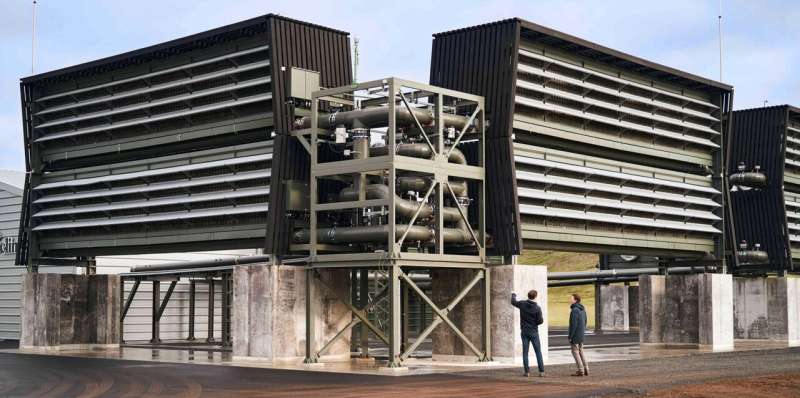This article has been reviewed according to Science X's editorial process and policies. Editors have highlighted the following attributes while ensuring the content's credibility:
fact-checked
peer-reviewed publication
trusted source
proofread
Cost of direct air carbon capture to remain higher than hoped

Switzerland plans to reduce its net carbon emissions to zero by no later than 2050. To achieve this, it will need to drastically reduce its greenhouse gas emissions. In its climate strategy, the Swiss government acknowledges that some of these emissions, particularly in agriculture and industry, are difficult or impossible to avoid.
Swiss climate policy therefore envisages actively removing 5 million metric tons of CO2 from the air and permanently storing it underground. By way of comparison, the Intergovernmental Panel on Climate Change (IPCC) estimates that up to 13 billion metric tons of CO2 will need to be removed from the atmosphere every year from 2050.
These targets will be hard to achieve unless ways can be found to reduce the cost of direct air capture (DAC) technologies. ETH spin-off Climeworks operates a plant in Iceland that currently captures 4,000 metric tons of CO2 a year, at a cost per metric ton of between 1,000 and 1,300 dollars. But how quickly can these costs come down as deployment increases?
ETH researchers have developed a new method that provides a more accurate estimate of the future cost of various DAC technologies. As the technologies are scaled up, direct air capture will become significantly cheaper—though not as cheap as some stakeholders currently anticipate. Rather than the oft-cited figure of 100 to 300 U.S. dollars, the researchers suggest the costs are more likely to be between 230 and 540 dollars.
"Just because DAC technologies are available, it certainly doesn't mean we can relax our efforts to cut carbon emissions. That said, it's still important to press ahead with the expansion of DAC plants, because we will need these technologies for emissions that are difficult or impossible to avoid," says Bjarne Steffen, ETH Professor of Climate Finance and Policy. He developed the new method together with Katrin Sievert, a doctoral student in his research group, and ETH Professor Tobias Schmidt.
Three technologies and their costs
The ETH researchers applied their method to three direct air capture technologies. The goal was to compare how the cost of each technology is likely to evolve over time. Their findings suggest that the process developed by Swiss company Climeworks, in which a solid filter with a large surface area traps CO2 particles, could cost between 280 and 580 U.S. dollars per metric ton by 2050.
The estimated costs of the other two DAC technologies fall within a similar range. The researchers calculated a price of between 230 and 540 dollars a metric ton for the capture of CO2 from the atmosphere using an aqueous solution of potassium hydroxide, a process that has been commercialized, for example, by Canadian company Carbon Engineering. The cost of carbon capture using calcium oxide derived from limestone was estimated at between 230 and 835 dollars. This latter method is offered by U.S. company Heirloom Carbon Technologies, among others.
Focus on components
Estimating how the cost of new technologies will change over time is particularly difficult in situations where very little empirical information is available. This lack of real-world data represents a challenge for DAC technologies: They haven't been in use long enough to allow projections to be made as to how their cost might evolve in the future.
To address this dilemma, the ETH researchers focused on the individual components of the different DAC systems and estimated their cost one by one. They then asked 30 industry experts to assess the design complexity of each technological component and determine how easy it would be to standardize.
The researchers based their work on certain assumptions: Namely, that the cost of less complex components that can be mass-produced will fall more sharply, while the cost of complex parts that must be tailored to each individual system will fall only slowly. DAC systems also include mature components such as compressors, which cannot feasibly be made much cheaper. Once the researchers had estimated the cost of each individual part, they then added the cost of integrating all the components and the costs of energy and operation.
Despite significant uncertainties in their calculations, the researchers' message was clear: "At present, it is not possible to predict which of the available technologies will prevail. It is therefore crucial that we continue to pursue all the options," says Katrin Sievert, lead author of the study, which was recently published in the journal Joule.
More information: Katrin Sievert et al, Considering technology characteristics to project future costs of direct air capture, Joule (2024). DOI: 10.1016/j.joule.2024.02.005


















